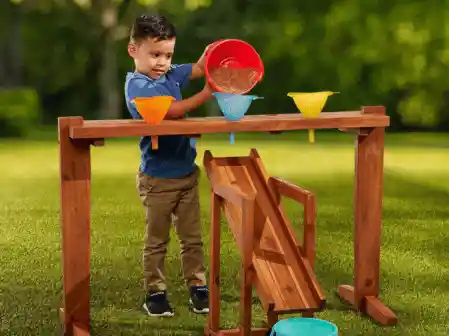STEM in Early Childhood

Sparking Curiosity:
The What, Why and How of STEM in Early Childhood
STEM—Science, Technology, Engineering, and Math—is more than a set of topics; it’s an integrated approach to learning that invites exploration and encourages problem-solving through hands-on activities. For our youngest learners, STEM isn’t about complex theories but about asking questions, experimenting, and observing cause and effect.
So, what exactly is STEM in an early childhood setting? Why is it valuable at this age, and how can teachers bring it to life in the classroom?
The What: Understanding STEM in Early Childhood
STEM is about laying the groundwork for inquiry, critical thinking, and problem-solving. Here's what each component looks like for young learners:
- Science - Encourage the exploration of the natural world! Whether its observing plants grow or experimenting with water, science helps children learn about their environment.
- Technology - In STEM, “technology” doesn’t always refer to computers, tablets, or digital coding materials. Tools like magnifying glasses and rulers, and simple machines like ramps, pulleys and levers are all considered technology. How can tools be used to solve everyday problems?
- Engineering - Design, build and test your construction! Stacking blocks to create a tower or constructing a bridge out of straws are simple examples of play-based engineering thinking!
- Math - Counting, recognizing patterns and sorting objects all lay the foundation for early math skills that grow into more sophisticated STEM thinking.
Opportunities to explore these concepts and make connections across categories encourage a mindset of discovery for young children.
The Why: Why STEM Matters
STEM education in early childhood goes beyond teaching facts. Children learn to ask thoughtful questions and work collaboratively with hands-on exploration. This builds critical thinking and communication skills, and comfort with trial and error as a natural and valuable part of learning. When they encounter a challenge, like building a structure that keeps falling, children are encouraged to adjust their approach and try again. This resilience builds confidence and a positive attitude toward problem-solving.
Early experiences in STEM help children develop a deeper understanding of the world around them—whether they’re observing the weather, counting objects, or exploring how things work. These foundational experiences lay the groundwork for fostering curiosity and inspire an ongoing love of discovery.
The How: Simple Strategies for Integrating STEM in Early Childhood
Integrating STEM into early childhood classrooms doesn’t require expensive materials or elaborate plans. It’s all about creating an environment that encourages curiosity, exploration, and hands-on learning. Here are some simple strategies to make STEM a natural part of your daily routine.
- Create a STEM-friendly environment! Design a space that invites exploration. Incorporate open-ended supplies, such as a variety of blocks, building manipulatives and loose parts. Tools like magnifying glasses, measuring tapes, and balances encourage inquiry and math thinking. Natural materials and everyday objects are also excellent tools for teaching STEM concepts. Does your environment allow for materials to travel from one area to another? Space that is organized yet flexible allows children to choose materials that inspire their creativity and curiosity.
- Sensory play equals STEM play! Water and sand play are incredibly engaging ways to introduce early science and math concepts. As children pour, sift, and construct rivers and dams, they’re also having hands-on experiences with buoyancy, erosion, capacity and more!
- Ask open-ended questions! Environment and materials aside, teacher-child interactions that spark deeper thinking are the most significant aspect of integrating STEM in your classroom. Instead of quickly providing answers, ask questions like, “What do you think will happen if we try this?” or “Why do you think that happened?” Model a mindset of inquiry and comfort with not having all of the answers. It’s incredibly powerful for children when teachers convey a mindset of joyful curiosity.
How to Begin with STEM?
Start small with activities you’re comfortable with and build from there. What are the children noticing about the world around them? Are there questions that regularly come up during their play, construction, outdoor time, or creative work? Learn to notice threads of curiosity and themes that children frequently find intriguing. What are you excited to learn more about? Your enthusiasm will be contagious! By embracing exploration, you’ll grow more confident over time, just as the children will. Remember that perfection is not the goal – in fact, a “failed” experiment might offer even more opportunity for practicing resilience, persistence, and scientific thinking!
However you choose to integrate STEM in your setting, children will benefit from your willingness to engage in the process of discovery. Embrace the journey, knowing that every small step you take inspires big possibilities for the future.
Join us for our upcoming webinar: Inspiring Playful Learning Through a STEM Lens.
Revisit STEM aligned webinar recordings: Ramp Up for STEM Discoveries and Ramp Up for STEM Discoveries: Downloadable Resource.
Recommended Products

Christine Murray is an Early Childhood Education Specialist with Becker’s Education Team.
As an educator, coach and leader, Christine is inspired by the curiosity, joy and wonder that children so generously model for us. She earned her M.A. in Innovative Early Childhood Education at the University of Colorado Denver and loves collaborating with and supporting others in the field. Grounded in relationships and guided by empathy, Christine is always learning, connecting and creating.







